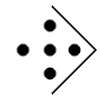"Alquerque" is actually the Spanish name for the game. It became popular there after it was brought to Spain by the Moors. The Arabic name for it was "el-quirkat." It is thousands of years old and has been played in Egypt and the Middle East. Part of a board for this game was carved into one of the stones used in the roof of the Egyptian temple at Kurna (c. 1400 BC). There are many versions of the game, some of which were described in the King Alfonso's Libro de Juegos (Book of Games) (Grunfeld 38). King Alfonso X (1251-1282 AD) was the King of Castile. The game later traveled to the Americas along with Spanish explorers, and versions of it became popular among Native Americans in what would later be the southwestern part of the United States (Provenzo and Provenzo 62).
Basically, Alquerque is an earlier version of Checkers, although it has not been replaced by Checkers and still played in modern times (Grunfeld 38, Provenzo and Provenzo 62). Different versions of the game use different numbers of pieces (Parlett 243). The rules given here are for the version with twelve pieces for each side, which seems to have been the most popular way to play throughout history (Provenzo and Provenzo 62).
Alquerque
There are many variations of this game. The version described here is from Play It Again by Asterie Baker Provenzo and Eugene F. Provenzo, Jr., pp. 62-65, with some extra information from Parlett's The Oxford History of Board Games, pp. 243-244.
Players: 2
Object: To be the first to capture the other player's pieces.
Equipment: Alquerque board (printable), two sets of 12 playing pieces (each set should be a different color, I recommend cutting small circles out of colored paper for these)

Set Up: The board is a series of straight and diagonal lines that intersect at 25 points, as shown in the picture. Alquerque boards don't always have the intersection points marked with dots; I added those just to make the placement of the pieces clear. There are two sets of 12 playing pieces, each a different color, one set for each player. For the sake of example, we'll use black and white as the colors. Place the black pieces on the black dots and the white pieces on the white dots. The middle dot (marked with red here) is left empty.
Moving:The two players take turns moving their pieces along the lines. A piece can be moved to any empty spot on the board which is immediately next to it along these lines. The first move, whichever side makes it, must be to the spot in the middle, marked in red, because it is the only open spot on the board at the beginning of the game (Parlett 243).
Capturing: If a piece is next to one that belongs to the other player and there is an empty space on the other side of the other player's piece, that piece can jump over the other player's piece to capture it (just like Checkers). Captured pieces are removed from the board. Also like in Checkers, players can jump and capture multiple pieces on the same turn. The pieces don't need to be neatly lined up for multiple captures; the capturing piece can change directions for multiple jumps.
If a player can make a capture but either overlooks it or chooses to ignore it, the other player can point it out and remove the piece that would have made the capture from the board as his own capture.
Winning: The winner is the one who captures all of the other player's pieces or completely blocks the other player from moving. If both players block each other from moving, the game is considered a draw.
Tips: It's traditional to roll dice to determine who will be the first play. The first player is at a disadvantage because he has no choice for the first move and because his playing strategy will be revealed first. Generally, if both players are equally experienced, the game will likely be a draw. These things were noted in the Libro de Juegos (Parlett 244).

